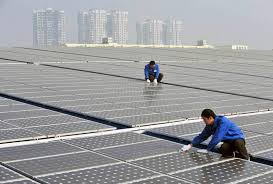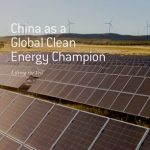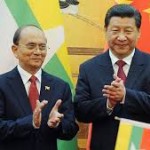
China’s massive investments in renewable energy
In early January 2017, China’s government announced a 2.5 trillion RMB (US$ 360 billion) investment programme in renewable energy as part of its 13th Five-Year Plan (2016-2020). This marks a continuation of the twin strategies of boosting the share of non-fossil fuel in the nation’s energy mix and supporting the growth and internationalisation of its renewable energy manufacturing industry. The programme is encapsulated in the five-years for Renewable Energy, Electrical Power, Solar Energy, and Wind Power. These plans are subordinate to the overall 13th Five-Year Plan for Energy Development that was released a few days later.
The energy component of the new Five-Year Plan builds directly on the previous plan. The 12th plan (2011-2015) highlighted the need to invest in renewable energy, particularly wind and solar photovoltaics (PV), in contrast to the 11th plan (2006-2010). The goals of the 12th plan were threefold: to constrain the rise of carbon dioxide emissions, reduce air pollution, and promote the renewable energy manufacturing industry. The government supported this strategy by introduced feed-in-tariffs for the first time through the revised Renewable Energy Law in 2009 and investing billions of yuan in renewable energy, research and development, and manufacturing.
This strategy succeeded beyond the expectations of the government. The installed capacity of grid-connected wind energy and solar PV in 2015 exceeded the planned targets (see table below), giving China the largest fleets of wind and solar PV in the world, ahead of the USA. The total non-fossil fuel capacity (including hydro, nuclear and biomass) doubled, taking the share from 27% to 35% of the national total. In addition, the country became the leading manufacturer in terms of quantity, flooding the international market and driving down prices for wind and solar PV equipment.
The availability of renewable electricity did not match the success in constructing new renewable electricity generating capacity. Hydro-electricity generation continued to fluctuate annually depending on rainfall. Wind farms and solar arrays suffered from a high degree of curtailment. Initially these problems arose from combinations of poor location, technical failures and lack of connection to the grid. Even as these problems were solved, the grid companies remained unwilling to give the renewable energy priority dispatch because of the high cost and the lack of flexible load to balance the intermittency. More recently, the national excess of available generating capacity has led some local governments to require the grid companies to dispatch thermal rather than renewable energy, for local economic and political reasons.
The government released the overarching 13th Five-Year Plan for 2016-2020 in April 2016. This set objectives for reducing carbon dioxide emissions intensity by 18% and boosting the share of non-fossil fuels in total primary energy consumption from 12% to 15%. The five-year plans for electrical power and renewable electricity released in early January 2017 provide further details (see table below). An estimated 2.5 trillion RMB is to be spent on several forms of renewable energy: 500 billion RMB on hydro, 700 billion RMB on wind energy, 1 trillion RMB on different forms of solar power, and the balance on biomass, solar water heating, and geothermal power. The overall aim is to raise the share of renewable energy in installed capacity from 35% to 39% as well as boosting the share of non-fossil fuel in the primary energy mix from 12% to 15%. This investment progamme is also expected to create 3 million new jobs, bringing the total in the renewable energy sector to 13 million.
Notable features of the new plan include the slowdown in the construction of conventional hydro capacity, a new emphasis on pump-storage hydro, and a surge in the growth of solar PV and solar thermal capacity. The shift of emphasis away from constructing large-scale hydro-electricity may reflect a belated recognition of the social and environmental costs of such projects. The priority given to pump-storage hydro is in response to the shortage of reactive power to balance the growing capacity of intermittent renewable energy, especially in the north of the country. The planned boost of capacity in solar PV and solar thermal capacity results from the realisation that these technologies offer huge opportunities in large parts of the country, provided appropriate economic incentives are put in place.
Experience has shown that the targets for installed capacity are likely to be met, though the government still has work to do to adjust the incentives for pump-storage hydro and solar energy. The wider challenge is to ensure that the maximum possible amount of non-fossil fuel energy is dispatched at a time of slower and less energy-intensive economic growth and when more than 200 GW of coal-fired capacity is under construction. During 2016, curtailment rates for wind and solar PV exceeded 40% in some provinces, and some nuclear power stations were used to provide following load rather than base load. Regardless of these domestic challenges, the new plans provide a signal to Chinese manufacturers of renewable energy equipment to pursue ambitious strategies both at home and abroad.
In conclusion, China’s renewable energy capacity will continue to grow, though with a switch of emphasis to solar PV and solar thermal, and the country’s manufacturing industry for renewable energy equipment is likely to thrive, though corporate consolidation will continue. Chinese companies may well increase their dominance of the international markets for renewable energy equipment and project development. The challenges for the industry are to improve technical reliability and sophistication. The challenge for government is to maximise the dispatch of non-fossil fuel electricity.
| Installed capacity, GW | 2010 | 2015
plan |
2015
actual |
2020 |
| Total | 970 | 1530 | 2000 | |
| Thermal | 710 | 993 | 1220 | |
| Coal | 900 | 1100 | ||
| Gas | 66 | 110 | ||
| Non-fossil fuel | 260 | 537 | 780 | |
| Hydro (total) | 216 | 290 | 320 | 380 |
| Of which: pump storage hydro | 15 | 30 | 23 | 40 |
| Wind (Grid connected) | 31 | 100 | 129 | 210 |
| Solar PV | 1 | 21 | 43 | 105 |
| Solar Thermal | 0.01 | 5 | ||
| Biomass | 5 | 13 | 10 | 15 |
| Nuclear | 11 | 27 | 58 | |
| Thermal % | 73% | 65% | 61% | |
| Non-fossil % | 27% | 35% | 39% |





